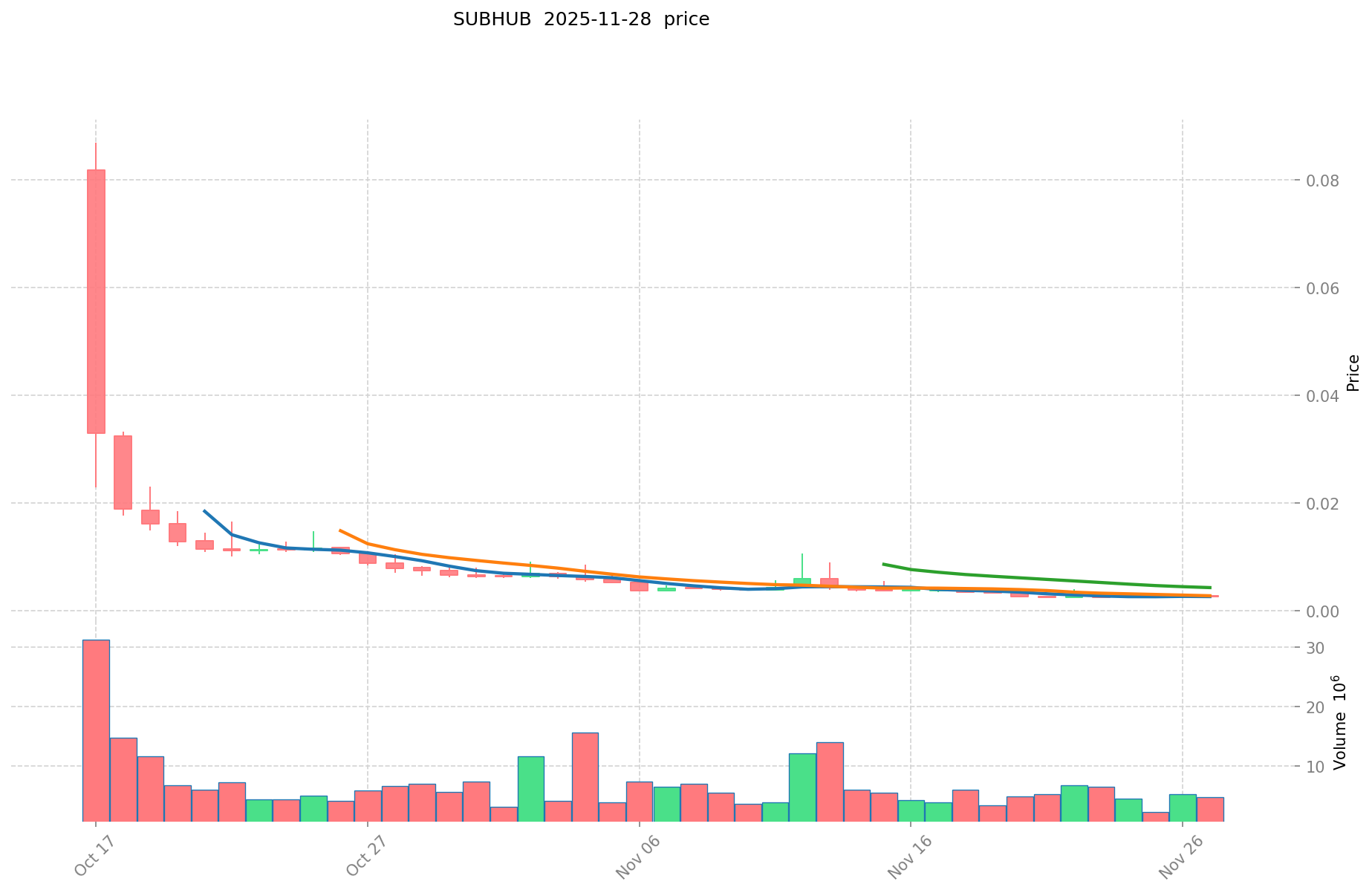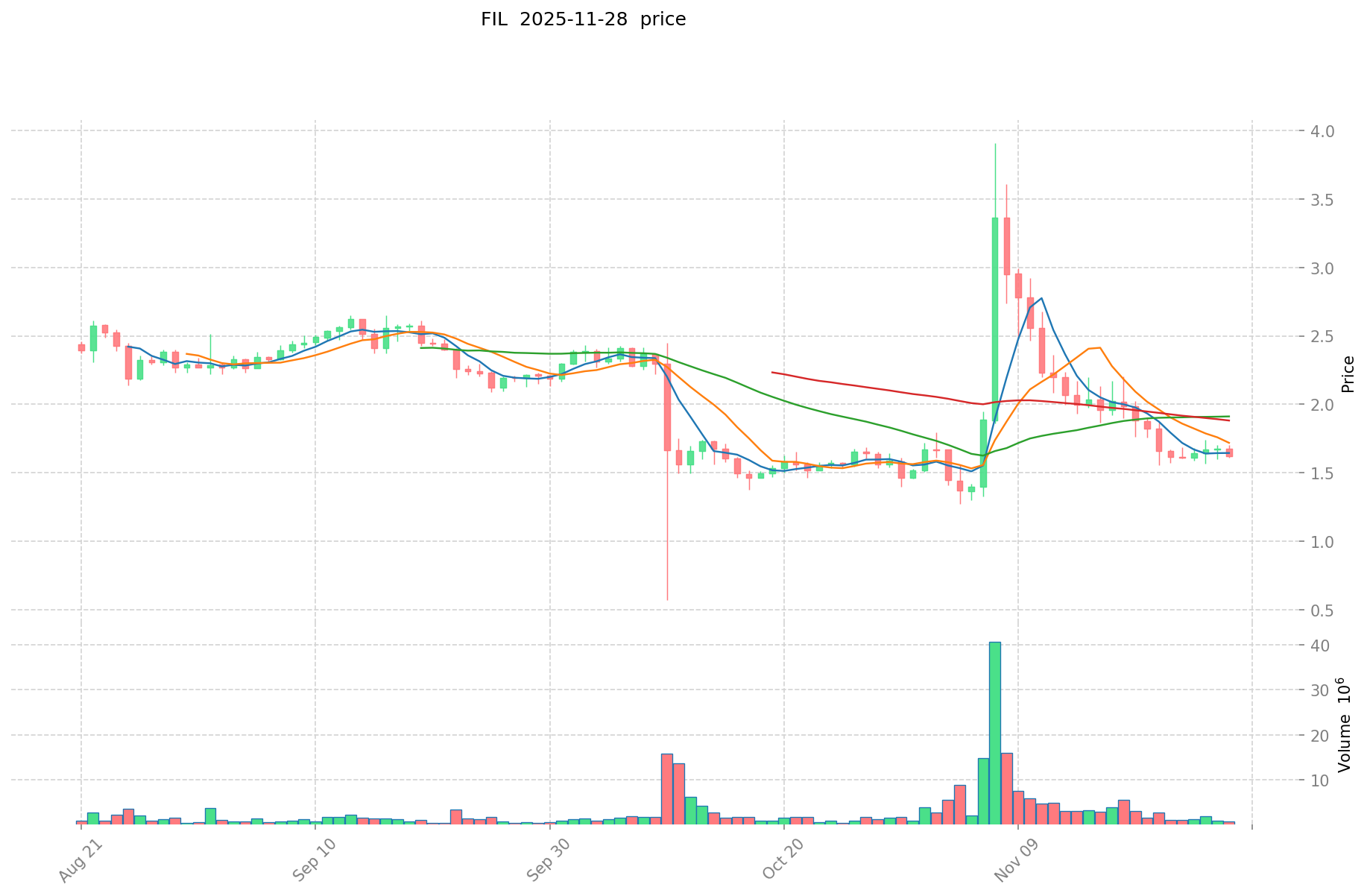SUBHUB vs FIL: A Comparative Analysis of Two Decentralized Storage Solutions
Introduction: Investment Comparison of SUBHUB vs FIL
In the cryptocurrency market, the comparison between SUBHUB vs FIL has been an unavoidable topic for investors. The two not only show significant differences in market cap ranking, application scenarios, and price performance but also represent different crypto asset positioning.
SUBHUB (SUBHUB): Since its launch, it has gained market recognition for its positioning as a cross-chain messaging and marketing hub for Web3.
Filecoin (FIL): Since its inception in 2020, it has been hailed as a decentralized storage network, and is one of the cryptocurrencies with high global trading volume and market capitalization.
This article will provide a comprehensive analysis of the investment value comparison between SUBHUB vs FIL, focusing on historical price trends, supply mechanisms, institutional adoption, technological ecosystems, and future predictions, attempting to answer the question most concerning investors:
"Which is the better buy right now?"
I. Price History Comparison and Current Market Status
SUBHUB (Coin A) and FIL (Coin B) Historical Price Trends
- 2025: SUBHUB reached its all-time high of $0.087 on October 17, followed by a significant drop to its all-time low of $0.002263 on November 21.
- 2021: FIL achieved its all-time high of $236.84 on April 1, demonstrating strong market performance.
- Comparative Analysis: In the recent market cycle, SUBHUB experienced a dramatic decline from $0.087 to $0.002263, while FIL has shown long-term price stability despite volatility, maintaining a price well above its all-time low of $0.848008 set on October 11, 2025.
Current Market Situation (2025-11-28)
- SUBHUB current price: $0.002608
- FIL current price: $1.602
- 24-hour trading volume: SUBHUB $13,157.64 vs FIL $1,116,777.03
- Market Sentiment Index (Fear & Greed Index): 25 (Extreme Fear)
Click to view real-time prices:
- View SUBHUB current price Market Price
- View FIL current price Market Price


II. Core Factors Affecting Investment Value of SUBHUB vs FIL
Supply Mechanism Comparison (Tokenomics)
-
SUBHUB: Fixed maximum supply of 10 billion tokens with a deflationary model through continuous token burns
-
FIL: Capped supply of 2 billion tokens with a halving mechanism every 6 years
-
📌 Historical pattern: Deflationary models like SUBHUB's tend to create upward price pressure as circulating supply decreases, while FIL's halving events typically trigger price discovery cycles similar to Bitcoin's pattern.
Institutional Adoption and Market Applications
- Institutional holdings: FIL has gained more institutional traction with investments from Grayscale, Digital Currency Group, and venture funds, while SUBHUB is still in early institutional adoption phase
- Enterprise adoption: FIL has established partnerships with major tech companies for decentralized storage solutions, while SUBHUB focuses on multi-chain applications in the decentralized data economy
- Regulatory attitudes: Both projects face similar regulatory scrutiny in most jurisdictions, with FIL having a slight advantage due to its longer operational history
Technical Development and Ecosystem Building
- SUBHUB technical upgrades: Multi-chain compatibility, improved AI data infrastructure, and interoperability solutions to connect various blockchains
- FIL technical development: Layer-2 scaling solutions, enterprise-grade storage verification, and expansion of retrieval market functionalities
- Ecosystem comparison: FIL has a more mature ecosystem for decentralized storage with hundreds of active storage providers, while SUBHUB focuses on broader data services including AI training data repositories, cross-chain data verification, and decentralized computing
Macroeconomic and Market Cycles
- Performance in inflationary environments: Both assets show potential as inflation hedges, with FIL more directly tied to real-world utility through storage services
- Macroeconomic monetary policy: Interest rate hikes have affected both assets similarly, with correlation to broader crypto market trends
- Geopolitical factors: Growing data sovereignty concerns globally could benefit both projects, with SUBHUB's multi-chain approach potentially offering more flexibility in diverse regulatory environments
III. 2025-2030 Price Prediction: SUBHUB vs FIL
Short-term Prediction (2025)
- SUBHUB: Conservative $0.001664 - $0.0026 | Optimistic $0.0026 - $0.003276
- FIL: Conservative $1.2776 - $1.597 | Optimistic $1.597 - $2.17192
Mid-term Prediction (2027)
- SUBHUB may enter a growth phase, with an estimated price range of $0.0023640617 - $0.0044825066
- FIL may enter a steady growth phase, with an estimated price range of $1.200777912 - $2.421907992
- Key drivers: Institutional capital inflow, ETF, ecosystem development
Long-term Prediction (2030)
- SUBHUB: Base scenario $0.004238490146962 - $0.004662339161658 | Optimistic scenario $0.004662339161658+
- FIL: Base scenario $3.1238316245331 - $4.123457744383692 | Optimistic scenario $4.123457744383692+
Disclaimer: The above predictions are based on historical data and market analysis. Cryptocurrency markets are highly volatile and unpredictable. This information should not be considered as financial advice. Always conduct your own research before making investment decisions.
SUBHUB:
| 年份 | 预测最高价 | 预测平均价格 | 预测最低价 | 涨跌幅 |
|---|---|---|---|---|
| 2025 | 0.003276 | 0.0026 | 0.001664 | 0 |
| 2026 | 0.00320242 | 0.002938 | 0.00202722 | 12 |
| 2027 | 0.0044825066 | 0.00307021 | 0.0023640617 | 17 |
| 2028 | 0.004493866377 | 0.0037763583 | 0.002076997065 | 44 |
| 2029 | 0.004341867955425 | 0.0041351123385 | 0.00297728088372 | 58 |
| 2030 | 0.004662339161658 | 0.004238490146962 | 0.004111335442553 | 62 |
FIL:
| 年份 | 预测最高价 | 预测平均价格 | 预测最低价 | 涨跌幅 |
|---|---|---|---|---|
| 2025 | 2.17192 | 1.597 | 1.2776 | 0 |
| 2026 | 2.1859736 | 1.88446 | 1.224899 | 17 |
| 2027 | 2.421907992 | 2.0352168 | 1.200777912 | 27 |
| 2028 | 2.83027424292 | 2.228562396 | 1.27028056572 | 39 |
| 2029 | 3.7182449296062 | 2.52941831946 | 1.4670626252868 | 57 |
| 2030 | 4.123457744383692 | 3.1238316245331 | 2.592780248362473 | 94 |
IV. Investment Strategy Comparison: SUBHUB vs FIL
Long-term vs Short-term Investment Strategies
- SUBHUB: Suitable for investors focused on multi-chain ecosystems and data economy potential
- FIL: Suitable for investors seeking stability and real-world utility in decentralized storage
Risk Management and Asset Allocation
- Conservative investors: SUBHUB: 20% vs FIL: 80%
- Aggressive investors: SUBHUB: 60% vs FIL: 40%
- Hedging tools: Stablecoin allocation, options, cross-currency portfolio
V. Potential Risk Comparison
Market Risks
- SUBHUB: High volatility, potential for sharp price swings
- FIL: Market saturation in decentralized storage sector
Technical Risks
- SUBHUB: Scalability, network stability
- FIL: Mining power concentration, security vulnerabilities
Regulatory Risks
- Global regulatory policies may have different impacts on both assets, with FIL potentially facing less scrutiny due to its longer operational history
VI. Conclusion: Which Is the Better Buy?
📌 Investment Value Summary:
- SUBHUB advantages: Multi-chain compatibility, deflationary model, broader data services ecosystem
- FIL advantages: Established decentralized storage network, institutional adoption, real-world utility
✅ Investment Advice:
- New investors: Consider a balanced approach with a higher allocation to FIL for its established market position
- Experienced investors: Explore SUBHUB for higher potential returns, while maintaining a significant FIL position
- Institutional investors: Diversify portfolio with both assets, leveraging FIL's storage utility and SUBHUB's cross-chain potential
⚠️ Risk Warning: Cryptocurrency markets are highly volatile. This article does not constitute investment advice. None
VII. FAQ
Q1: What are the main differences between SUBHUB and FIL? A: SUBHUB is positioned as a cross-chain messaging and marketing hub for Web3, while FIL is a decentralized storage network. SUBHUB has a fixed maximum supply of 10 billion tokens with a deflationary model, whereas FIL has a capped supply of 2 billion tokens with a halving mechanism every 6 years.
Q2: Which cryptocurrency has shown better price performance recently? A: FIL has shown more long-term price stability despite volatility, maintaining a price well above its all-time low. SUBHUB, on the other hand, experienced a dramatic decline from its all-time high to its current price in the recent market cycle.
Q3: How do the market capitalizations and trading volumes of SUBHUB and FIL compare? A: FIL has a significantly higher market capitalization and 24-hour trading volume compared to SUBHUB. As of 2025-11-28, FIL's 24-hour trading volume was $1,116,777.03, while SUBHUB's was $13,157.64.
Q4: What are the key factors affecting the investment value of SUBHUB and FIL? A: Key factors include supply mechanisms, institutional adoption, market applications, technical development, ecosystem building, and macroeconomic conditions. FIL has gained more institutional traction and has established partnerships with major tech companies, while SUBHUB focuses on multi-chain applications in the decentralized data economy.
Q5: How do the long-term price predictions for SUBHUB and FIL compare? A: By 2030, SUBHUB's base scenario price range is predicted to be $0.004238490146962 - $0.004662339161658, while FIL's base scenario range is expected to be $3.1238316245331 - $4.123457744383692. Both have potential for higher prices in optimistic scenarios.
Q6: What are the main risks associated with investing in SUBHUB and FIL? A: For SUBHUB, main risks include high volatility, potential for sharp price swings, and technical risks related to scalability and network stability. For FIL, risks include market saturation in the decentralized storage sector, mining power concentration, and potential security vulnerabilities.
Q7: How should investors allocate their portfolios between SUBHUB and FIL? A: Conservative investors might consider allocating 20% to SUBHUB and 80% to FIL, while aggressive investors might opt for 60% SUBHUB and 40% FIL. New investors may want to focus more on FIL due to its established market position, while experienced investors could explore SUBHUB for higher potential returns.
Share
Content